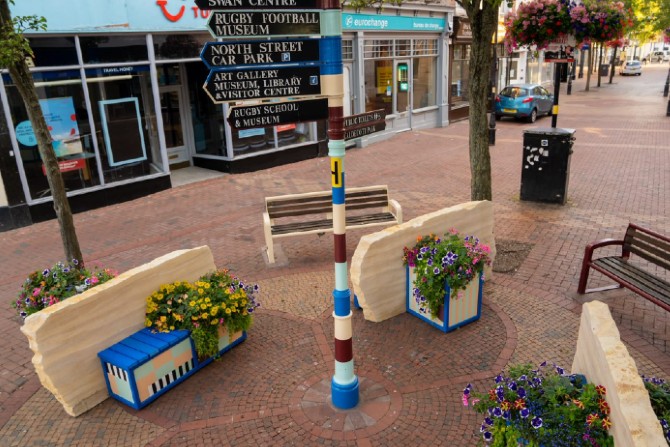Rugby is the second largest market town in Warwickshire. The town has a world-renowned heritage as the birthplace of the sport and one of the oldest schools in the country. Rugby School, which started in 1567, is now an independent boarding school. Culturally the town is well known for its grass-roots music and thriving exhibitions and events programme at the gallery and museum. Rugby Borough Council’s Town Centre Regeneration Project is setting the stage for an ambitious redevelopment of the town centre which includes ‘Greening Street and Spaces’ as one of the big ideas.
Rugby Town Centre - Explaining the big ideas
When residents were asked for their thoughts about Rugby - which then formed part of the artists’ brief for this project - they said how proud they are of the town’s heritage and its architecture. They’d said they’d like to see more interesting meeting points and more greenery in the town centre.
Architects, Studio MUTT have created a ‘micro’ park for Market Place, Rugby High Street, a short walk from Rugby Gallery and Museum. The space has been designed as a meeting point, a place to socialise and rest with benches and planting.
The name ‘Butter Stones’ refers to ‘butter crosses’ - historic market town structures where butter was once sold on market days. Before their use as butter crosses, and long after, these structures had a variety of other uses. ‘Rugby Butter Stones’ is designed to have a similar flexibility of use.
The design uses split rock which gives texture and interest. 'Rugby Butter Stones’ was inspired by Rugby’s history as a market town, and it’s impressive architecture, particularly it’s rare collection of buildings by the Gothic Revival Architect, William Butterfield, with their display of clashing colours and patterns.
The smaller scale allows for a greater investigation into higher quality materials. The stone links to the rock face-like school building with its brick strata and the dominant use of stone in other civic landmarks.
Butterfieldtown
The stones and patterns in the piece are inspired by many of the town’s historic buildings, which were designed by renowned 19th century, gothic revival architect, William Butterfield. Indeed, Nikolaus Pevsner, the art and architecture critic famous for his guide to British Architecture, once described Rugby as ‘Butterfieldtown’ - on account of the number of William Butterfield buildings in the town, including Rugby School and elements of St Andrews Church.
Butterfield, best known for using numerous colours in brick and masonry, was a recipient of the prestigious Royal Institute of British Architects (RIBA) gold medal in 1884.
The structure invites exploration and conversation, as well as helping to create a more interesting environment and encourage reflection about what is unique to the town.
Market Place, Rugby High Street location
The natural meeting space the project has enhanced provides scope for a range of community activities and has already engendered the interest of local groups in the arts and cultural sector who are looking for additional creative projects to work on.
One such project has been the creation of a soundscape which captures the sounds of Rugby town through time. Created by local musicians, this project creates space for us to reflect on Rugby’s vibrant cultural offer. You can listen to the sounds and learn more about the project by clicking the link below.
